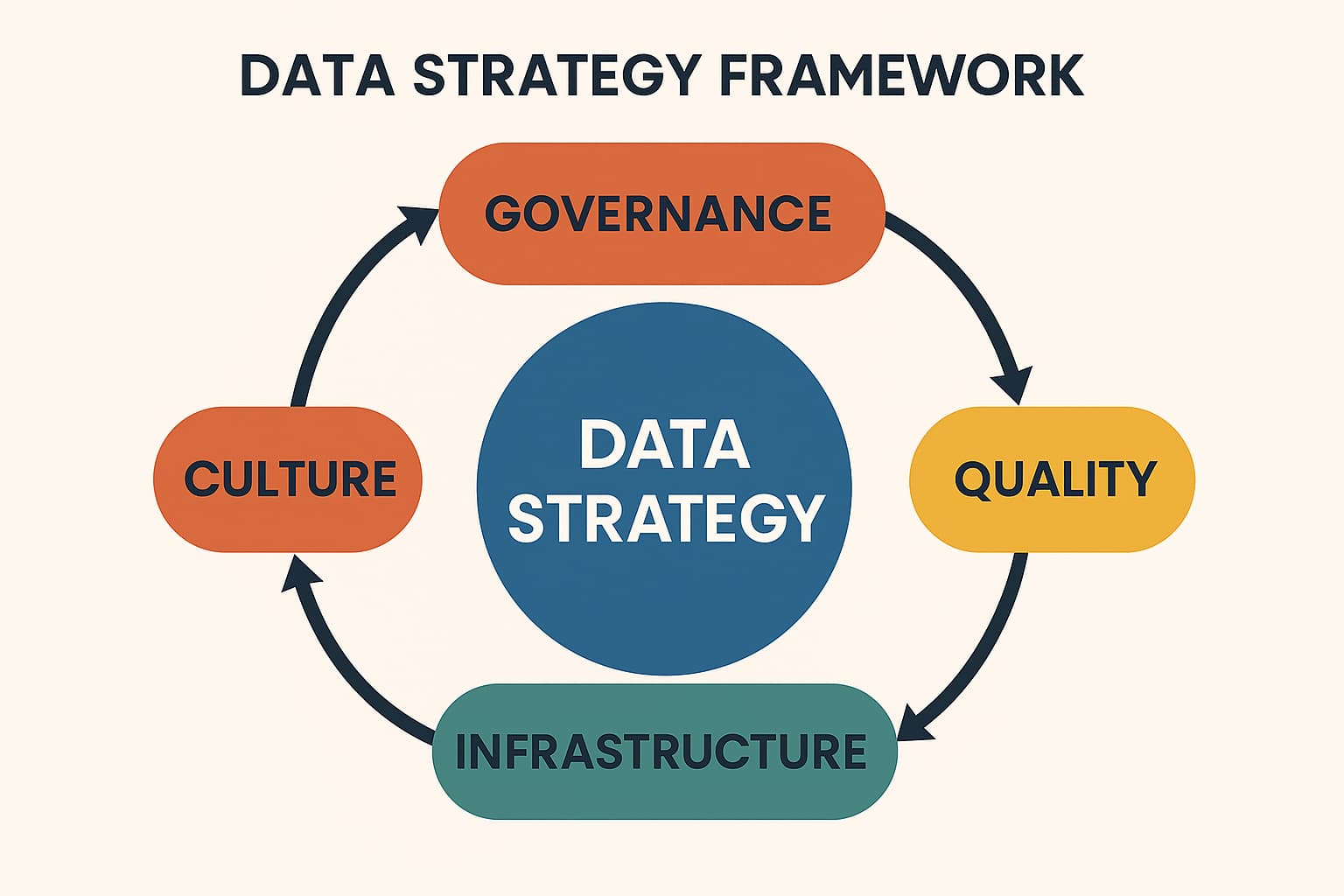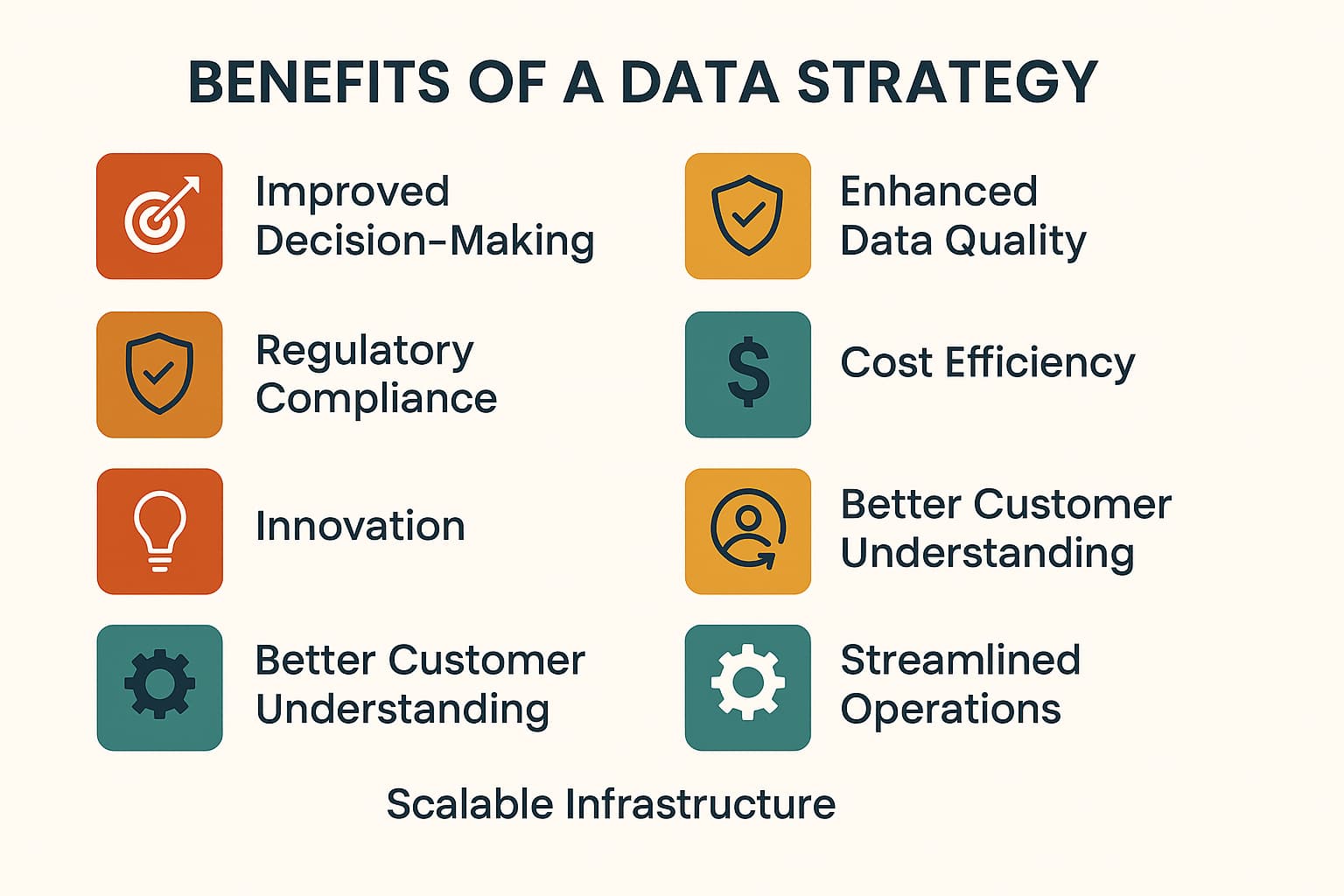In today’s fast-paced business landscape, companies are sitting on a goldmine of data, but only those with a strong data strategy are turning that data into real value. While buzzwords like “digital transformation” and “big data” get thrown around often, the reality is simple: without a clear plan for managing, analyzing, and using data, businesses are leaving money and insights on the table.
Take MetroMarket, a fictional mid-sized retail chain with 30 stores. A few years ago, it was flying blind: siloed data, slow reporting, guesswork-based planning. After implementing a well-structured data strategy, the company experienced significant gains, from better customer understanding to streamlined operations and faster decision-making.
Let’s explore how a smart data strategy can unlock real business benefits, illustrated by MetroMarket’s transformation.
Improved Decision-Making
Before MetroMarket adopted a company-wide data strategy, decision-making was fragmented and often delayed. Store managers relied on outdated spreadsheets, marketing ran blind campaigns, and executives lacked visibility into what was happening across locations.
By centralizing data and introducing real-time dashboards, the business empowered every level of the organization with facts, not hunches. Store managers began using daily sales trends to adjust restocking. Executives analyzed cross-store performance to plan new openings. Marketing teams reviewed campaign ROI instantly.
A good data strategy doesn’t just collect data; it makes it usable. When insights are timely and accessible, decisions become faster, sharper, and far more accurate.

Enhanced Data Quality & Consistency
Data chaos was costing MetroMarket time and credibility. Product names varied between stores, duplicate customer records confused marketing, and finance reports showed mismatched totals due to inconsistent inputs.
Once MetroMarket implemented standardized naming conventions, validation rules, and data cleansing procedures, quality and consistency skyrocketed. The marketing team now targeted the right customers with clean lists, while sales forecasting became significantly more accurate.
A strong data strategy ensures that data is reliable and speaks the same language across departments. This eliminates confusion and builds confidence in every report or dashboard.
الامتثال التنظيمي
In an era of strict privacy laws and increasing scrutiny over how customer data is used, MetroMarket knew it couldn’t afford to remain casual about compliance.
Before their data strategy, opt-out preferences were stored in multiple systems, making it hard to honor customer requests. Access to sensitive information was poorly tracked.
By embedding compliance into the data strategy through access controls, audit logs, and consent-tracking, MetroMarket gained control and clarity. Now, customer privacy preferences are centralized, only authorized teams can view sensitive data, and compliance audits are smooth and stress-free.
Data governance is a key pillar of any modern data strategy, helping businesses stay secure, legal, and trusted.
كفاءة التكلفة
Inefficiency is expensive, and MetroMarket learned that the hard way. Employees were spending hours compiling manual reports, correcting errors, and hunting down missing files.
Once the company automated reporting, integrated systems, and removed redundancies, the time and labor saved were substantial. Teams could now focus on analysis rather than administration. Better forecasting meant smarter procurement, reducing waste and avoiding overstock.
A strategic approach to data minimizes duplication, manual effort, and operational delays. The result is a leaner, more efficient organization and a direct impact on the bottom line.
Innovation & Competitive Advantage
Data isn’t just about what’s happening now; it’s a window into what could happen next. With a modern data strategy in place, MetroMarket started identifying emerging trends before competitors did.
One breakthrough came when the analytics team noticed a growing interest in eco-friendly home products across several regions. They launched a new product line months before rival retailers caught on, and the early-mover advantage paid off big.
With centralized analytics and a culture of experimentation, MetroMarket started testing promotions, refining product mixes, and optimizing supply chains faster than ever.
A well-defined data strategy fuels innovation by helping businesses spot opportunities, test ideas quickly, and scale what works.
Better Customer Understanding
Prior to building a customer data platform, MetroMarket’s marketing efforts were generic. They blasted emails to their full list, offered blanket discounts, and had little visibility into who their best customers were.
Through data integration across point-of-sale, website, and loyalty systems, the company built rich customer profiles. Now they segment shoppers by behavior, personalize offers, and predict what each customer is likely to want next.
For instance, a segment of high-value coffee buyers began receiving bundled offers, driving up basket size. Another group of occasional shoppers received targeted win-back campaigns.
By unifying and analyzing customer data, MetroMarket created a more personal, relevant experience, leading to increased loyalty and higher customer lifetime value.
Streamlined Operations
MetroMarket’s supply chain was once full of guesswork. Distribution centers didn’t know what stores really needed. Stores couldn’t see warehouse inventory in real time. Communication delays led to stockouts or over-ordering.
A revamped data strategy gave every part of the business access to live inventory levels, sales forecasts, and logistics timelines. The result? Smoother operations.
Store managers stopped over-ordering. Distribution centers optimized shipments. Automated alerts notified staff of low stock before it became an issue.
By aligning data across departments and systems, MetroMarket turned operational friction into flow. What once took days could now happen in minutes with fewer errors and far less manual coordination.
Scalable Infrastructure
As MetroMarket grew, its outdated systems struggled to keep up. Adding a new store meant building new data pipelines from scratch. During peak shopping days, systems slowed down, risking customer dissatisfaction.
By migrating to a scalable cloud-based data platform as part of their strategy, MetroMarket ensured the infrastructure could grow with them. Whether they opened 1 new store or 10, data could be integrated quickly and performance remained stable, even during sales surges.
Scalable infrastructure is the foundation of any long-term data strategy. It supports agility, growth, and resilience.
How to Get Started: 8 Practical Steps
Ready to start your own data strategy journey? Here’s a simple framework that works for businesses of all sizes:
1. Audit Your Current Data
Identify what data you have, where it lives, and who uses it. Find gaps, overlaps, and problem areas.
2. Set Clear Goals
Tie your data strategy to specific business goals like improving retention, reducing costs, or launching new products.
3. Build Cross-Functional Alignment
Bring together IT, marketing, operations, finance, and leadership. Everyone should understand the value and share ownership.
4. Define Governance Rules
Set policies for data access, privacy, validation, and cleanup. Assign ownership and responsibilities.
5. Invest in the Right Tools
Choose platforms that suit your scale and growth plans like cloud data warehouses, BI dashboards, customer data platforms, etc.
6. Start Small with High-Impact Projects
Pick a specific area (like inventory or marketing segmentation) where better data can quickly show results.
7. Measure and Optimize
Track ROI, report success, and refine the process. Use metrics to show progress and build support.
8. Make Data Culture Part of the Business
Encourage questions, curiosity, and data-informed decisions at every level of your organization.
Final Thoughts
MetroMarket’s journey proves that a smart data strategy isn’t just for tech giants; it’s a game-changer for any organization that wants to grow smarter, faster, and stronger.
From decision-making to compliance, cost savings to customer insights, the benefits are wide-reaching and highly measurable. In a world where business success is tied to data, having a clear strategy is no longer optional.
Start small. Get your data in order. Build momentum. And watch how the right strategy turns your data into a powerful driver of transformation.
Book a Free Strategy Session with Our Data Experts!
FAQs:
1. What is the main goal of a data strategy?
To align data use with business goals by ensuring data is accessible, accurate, and actionable across the organization.
2. How does a data strategy improve decision-making?
It centralizes and structures data so teams can access real-time insights, reducing guesswork and improving accuracy.
3. Can small businesses benefit from a data strategy?
Yes. Even basic strategies—like cleaning data and using simple dashboards—can boost efficiency, customer targeting, and growth.
4. What are the key components of a strong data strategy?
Governance, data quality, infrastructure, security, analytics tools, and alignment with business objectives.
5. How long does it take to see results from a data strategy?
Many businesses see impact within 3–6 months, especially when starting with high-priority use cases like reporting or customer insights.








